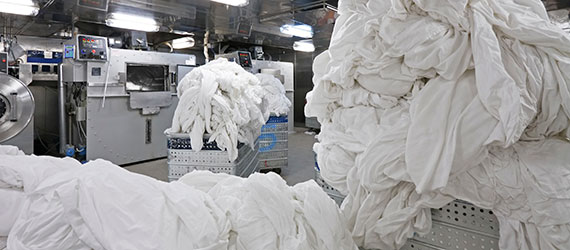The cleaning and care of textiles is another field where there are hygiene needs to be met right across the institutional and industrial spectrum. Hospitals and nursing homes, food factories and shops, restaurants and canteens, hotels, leisure facilities and even prisons all must have clothing and other textiles that are clean, comfortable and hygienic.

Textiles can harbour and allow the spread of micro-organisms that can transmit infection and affect the safety and/or quality of food. In all these settings, ensuring textiles are free from microbial contamination is of the utmost importance where textiles are used, and shared at different times, by patients and customers, or used by staff providing care or handling food.
Depending on the field of use and the size of the organisation, textiles for such uses may be washed in large industrial washers with high throughput rates or sometimes in smaller units not very different from the domestic washing machine.
Whichever is the case, washing processes must be designed to ensure the removal of the various soils with which clothing and textiles used in these fields come into contact, and the reliable disinfection of the item. The process design must take care of factors such as the nature and extent of the soils to be washed away, of the microbes to be removed or inactivated, and the nature and characteristics of the textile. It must take account of the size and design of the equipment, and of interfering factors such as water hardness. The process must specify a dose of product, a processing time and a temperature which, together with an appropriate input of mechanical action, can guarantee satisfactory cleaning and hygiene results with minimum use of product and energy.

Disinfection of textiles is achieved by a combination of physical removal (promoted by the combination of detergent, water, mechanical action and subsequent rinsing) and inactivation microbes. This latter component may be achieved by thermal means (i.e. washing at higher temperatures) and/or by chemical inactivation by a biocidal ingredient, assisted in each case by final drying, which may also use elevated temperatures. It is important to ensure that microbes that are physically removed rather than inactivated are thoroughly rinsed away, and not redeposited elsewhere in the same, or a subsequent load.
Optimization of hygiene in the laundry process is also helped by using a HACCP style approach. These will typically define adequate routines for:
- Washing processes.
- Press and rinse water microbiological quality.
- Drying.
- After treatment and transport (prevention of recontamination).
- Personal hygiene of laundry personnel.
Especially in larger machines, effective hygiene results with minimum use of product and energy are ensured by use of automatic, computer-controlled, dosing.
Chemical inactivation of microbes in the laundry process is most often delivered by oxidising agents such as peroxygen or hypochlorite bleaches. These products release peracetic acid or hypochlorite respectively. Peroxygen bleaches (such as perborate or percarbonate) work most efficiently at higher temperatures (60°C and above), though peracetic acid can be used to help deliver disinfection at lower temperatures. Hypochlorite and similar bleaches are used in many countries for bleaching white textiles at low temperatures.